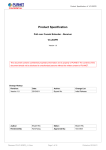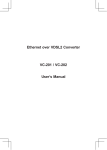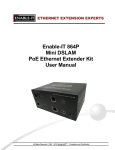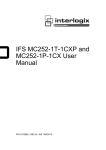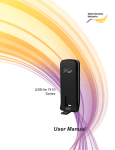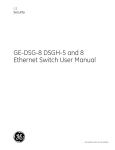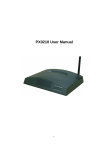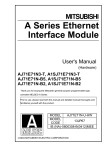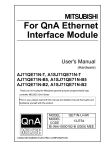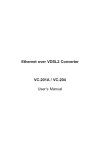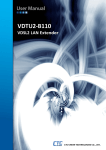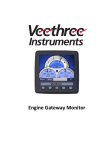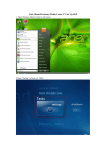Download MCE-Coax Converter User Manual
Transcript
GE Security MCE-Coax Converter User Manual P/N 1069177 • REV 1.0 • ISS 22FEB10 Copyright © 2010 GE Security, Inc. This document may not be copied in whole or in part or otherwise reproduced without prior written consent from GE Security, Inc., except where specifically permitted under US and international copyright law. Disclaimer The information in this document is subject to change without notice. GE Security, Inc. (“GE Security”) assumes no responsibility for inaccuracies or omissions and specifically disclaims any liabilities, losses, or risks, personal or otherwise, incurred as a consequence, directly or indirectly, of the use or application of any of the contents of this document. For the latest documentation, contact your local supplier or visit us online at www.gesecurity.com. This publication may contain examples of screen captures and reports used in daily operations. Examples may include fictitious names of individuals and companies. Any similarity to names and addresses of actual businesses or persons is entirely coincidental. Trademarks and patents GE and the GE monogram are trademarks of General Electric Company. Other trade names used in this document may be trademarks or registered trademarks of the manufacturers or vendors of the respective products. Intended use FCC compliance Use this product only for the purpose it was designed for; refer to the data sheet and user documentation for details. For the latest product information, contact your local supplier or visit us online at www.gesecurity.com. This equipment has been tested and found to comply with the limits for a Class A digital device, pursuant to part 15 of the FCC Rules. These limits are designed to provide reasonable protection against harmful interference when the equipment is operated in a commercial environment. This equipment generates, uses, and can radiate radio frequency energy and, if not installed and used in accordance with the instruction manual, may cause harmful interference to radio communications. You are cautioned that any changes or modifications not expressly approved by the party responsible for compliance could void the user's authority to operate the equipment. Regulatory information N4131 Manufacturer GE Security, Inc. HQ and regulatory responsibility: GE Security, Inc., 8985 Town Center Parkway, Bradenton, FL 34202, USA EU authorized manufacturing representative: GE Security B.V., Kelvinstraat 7, 6003 DH Weert, The Netherlands European Union directives 2002/96/EC (WEEE directive): Products marked with this symbol cannot be disposed of as unsorted municipal waste in the European Union. For proper recycling, return this product to your local supplier upon the purchase of equivalent new equipment, or dispose of it at designated collection points. For more information see: www.recyclethis.info. Contact information For contact information see our Web site: www.gesecurity.com. For contact information see our Web site: www.gesecurity.eu. Content Chapter 1 Introduction 1 Package Contents 1 Introduction 2 MCE-Coax Features 4 Product Specifications 4 Chapter 2 Hardware Overview 7 Front Panel 7 LED Indicators 8 The Back Panel 9 Power Information 10 Chapter 3 Installtion 13 Installing Ethernet with the VDSL2 Converter 13 Connecting MCE-Coax 14 Chapter 4 Troubleshooting and FAQs 17 Troubleshooting 17 FAQs 18 MCE-Coax Converter User Manual i ii MCE-Coax Converter User Manual Chapter 1 Introduction The GE Security MCE-Coax is a high-performance Ethernet-over-VDSL2 product that converts data between twisted pair (UTP) and coaxial wiring. Package Contents Check the contents of your package for following parts: • Ethernet over VDSL2 Converter – Coaxial x1 • User's Manual x1 If any of these items are missing or damaged, please contact your dealer immediately. MCE-Coax Converter User Manual 1 Chapter 1: Introduction Introduction GE Security's state-of-the-art Ethernet-over-VDSL2 products are based on two core networking technologies: Ethernet and VDSL2 (Very-high-datarate Digital Subscriber Line 2). This technology offers the absolute fastest possible data transmission speeds over existing coaxial cables without the need for rewiring. The MCE-Coax Ethernet over VDSL2 converters have a switching architecture with one RJ-45 10/100Mbps Ethernet port and one asymmetric Ethernet over VDSL port. The VDSL port uses a BNC connector. The MCE-Coax can be set to CO mode or CPE mode via a DIP switch. When the MCE-Coax-CO is used to connect to the other MCE-Coax-CPE as a standalone pair, you can get up to a 100/65Mbps asymmetric data rate within 200m and up to 70/10Mbps asymmetric data rate at 1.6km. This capability is ideal for use as an Ethernet extender for your existing Ethernet network. GE Security's VDSL2 Converter solution provides a much cheaper replacement and smoother migration for existing Long Reach Ethernet (LRE) networks. The cable specifications of the connection are listed as following: • 10Base-T, Category 3, 4 or 5 UTP • 100Base-TX, Category 5, 5e, 6 UTP • Ethernet over VDSL, Coaxial cable Figure 1 shows a typical application for the Ethernet over VDSL converter. NOTE: Slave device (CPE) must connect to Master device (CO) through the telephone wire. Slave cannot connect to Slave and Master cannot connect to Master. To define the MCE-Coax to CO or CPE, please refer to the Mode DIP Switch section for more detail. 2 MCE-Coax Converter User Manual Chapter 1: Introduction Figure 1: Typical application MCE-Coax Converter User Manual 3 Chapter 1: Introduction MCE-Coax Features The MCE0Coax Converter has the following key features: • Cost-effective VDSL2 CO/CPE bridge solution • One box design, CO/CPE selectable via DIP Switch • Complies with IEEE 802.3, IEEE 802.3u and IEEE 802.3x standards • DMT (Discrete Multi-Tone) line coding • Half duplex Back pressure and IEEE 802.3x Full Duplex Pause frame flow control • Support up to 1536 bytes packet size, 802.1Q VLAN tag transparent • VDSL2 stand-alone transceiver for simple bridge modem application • Minimal installation time (Simply as Plug-and-Play) • Selectable target data rate and target SNR margin • Support extensive LED indicators for network diagnostics • Compact in size, easy installation Product Specifications Hardware Specification Ports 10/100Base-TX 1 RJ-45, Auto-negotiation and Auto-MDI/MDI-X VDSL 1 BNC, female connector DIP Switch 4 position DIP switch CO / CPE mode select Functionality Selectable Fast and Interleaved mode Selectable target Data Rate Selectable target SNR mode Encoding 4 VDSL-DMT - ITU-T G.993.1 VDSL MCE-Coax Converter User Manual Chapter 1: Introduction - ITU-T G.997.1 - ITU-T G.993.2 VDSL2 (Profile 12a Support), Annex A One Power 3 for RJ-11/VDSL2 WAN : LED Indicators • Green, LNK/ACT • Green, CO mode • Green, CPE mode 2 for RJ-45 10/100Base-TX port Ethernet • Green, LNK/ACT. • Green, Speed 10Base-T: 2-pair UTP Cat.3, 4, 5 up to 100m (328ft) 100Base-TX: 2-pair UTP Cat.5, 5e up to 100m (328ft) Cabling VDSL 50 ohm, RG58A/U, RG58C/U, RG58/U or equivalent 200m -> 100/65Mbps Performance* 400m -> 100/65Mbps (Down Stream / Up Stream) 600m -> 100/58Mbps 800m -> 100/52Mbps 1000m -> 100/42Mbps 1600m-> 70/10Mbps Power Requirement 5V DC 2A Operating Temperature 0-50ºC Storage Temperature -25-70ºC Operating Humidity 10% to 90%, relative humidity, non-condensing Storage Humidity 10% to 90%, relative humidity, non-condensing Standard Conformance Regulation Compliance FCC Part 15 Class A, CE MCE-Coax Converter User Manual 5 Chapter 1: Introduction IEEE 802.3 10Base-T IEEE 802.3u 100Base-TX IEEE 802.3x Flow Control Standards Compliance ITU-T G.993.1 (VDSL) G.997.1 G.993.2 VDSL2 (Profile 12a Support), Annex A *The actual data rate will vary on the quality of the coaxial cable and environment factors. Physical Specifications Dimensions (W × D × H): 3.82” x 2.76” x 1.02” / 97 x 70 x 26mm Weight: 0.44 lbs / 200g Environmental Specifications Operating: Temperature: 0°C - 50°C Relative Humidity: 5% - 90% (non-condensing) Storage: Temperature: -20°C - 70°C Relative Humidity: 5% - 90% (non-condensing) Electrical Specifications Power Requirement: 5V, 2A Power Consumption: 5.60Watts/19 BTU (maximum) 6 MCE-Coax Converter User Manual Chapter 2 Hardware Overview MCE-Coax provides 1 BNC connector and supports 50-ohm cable with a distance of up to 1.6km. It has 1 RJ-45 port for two different running speeds 10Mbps, 100Mbps, in the same converter and automatically distinguishes the speed of incoming connection. This section describes the hardware features of these Converters. For easier control of the converter, familiarize yourself with its display indicators, and ports. Front panel illustrations in this chapter display the unit LED indicators. Before connecting any network device to the converter, read this chapter carefully. Front Panel The MCE-Coax front panel provides a simple interface monitoring the converter. Figure 2: MCE-Coax front panel MCE-Coax Converter User Manual 7 Chapter 2: Hardware Overview LED Indicators The diagnostic LEDs on the front panel provide the operating status of individual ports and the whole system. System LED Color PWR Green Function Lit: Power ON Off: Power OFF VDSL LED LNK/ACT Color Function Lit: Indicates that the VDSL link is established. Fast Blink: Indicates that the VDSL link is at training status(about 10 seconds) Green Slow Blink: Indicates that the VDSL link is at idle status Off: Indicates that the port is link down CO Green Lit: Indicates the VDSL Bridge is running at CO mode CPE Green Lit: Indicates the VDSL Bridge is running at CPE mode 10/100Base-TX Port LED LNK/ACT 100 8 Color Green Green Function Lit: Indicates that the port is link up. Blink: Indicates that the Converter is actively sending or receiving data over that port Off: Indicates that the port is link down Lit: Indicates that the port is operating at 100Mbps. Off: Indicates that the port is link down or 10Mbps. MCE-Coax Converter User Manual Chapter 2: Hardware Overview The Back Panel The back panel of the MCE-Coax is shown below. Figure 3: MCE-Coax back panel MODE DIP Switch The MCE-Coax has 4 selective transmission modes. By switching between the transmission modes, you can obtain the best transmission mode to suit your phone line quality or distance of connectivity. The following is the summary table of transmission settings, bandwidth and distance extensibility without noise and cross talk. DIP-1 DIP-2 DIP-3 DIP-4 Mode Channel Rate Limit SNR OFF CO Interleave 50/20 Mbps 9dB ON(default) CPE Fast No Limit 6dB CO / CPE • CO (Central Office) - the Master device mode, usually the CO device will be located at the data center of ISP or enterprise to link to the backbone. • CPE (customer premises equipment) - the Slave device mode, usually the CPE device will be located at a branch office, home or remote side as MCE-Coax Converter User Manual 9 Chapter 2: Hardware Overview a long reach data receiver. The CPE can be connected to the PC, IP Camera or Wireless Access Point and various network devices. Fast and Interleave mode: (For CO Mode only) • Fast mode guarantees a minimum end to end latency of less than 1 ms. • Interleaved mode provides impulse noises protection for any impulse noise with a duration less than 250 us. Interleaved mode has a maximum end to end latency of 10m sec. Rate Limit: (For CO Mode only) User has the ability to select fixed data rate. When a Rate Limit is selected, the system will lock the data rate at 50Mbps/20Mbps whenever the calculated SNR margin is higher than 9 dB. This gives the best system stability. Target SNR (Signal Noise Ratio) Margin: (For CO Mode only) When a fixed SNR margin is selected, the system will maintain the SNR margin at 9 dB across all usable loop length. Power Information Remove power from the converter before making any transmission mode adjustments. MCE-Coax requires 5V DC power input. NOTE: The device is a power-required device, that means, it will not work untill it is powered. If your networks are active all the time, please consider using UPS (Uninterrupted Power Supply) for your device. It will prevent network data loss or network downtime. In some areas, installing a surge suppression device may also help to protect your converter from being damaged by unregulated surge or current to the converter or the power adapter. 10 MCE-Coax Converter User Manual Chapter 2: Hardware Overview Power Jack The power jack of the MCE-Coax is with a 2.5mm central post and requires +5VDC power input. The MCE-Coax DOES NOT come bundled with an AC-DC adapter. The DC receptacle is 2.5mm wide, which conforms to and matches the VDSL2 Converter 2.5mm DC jack's central post. Figure 4: The power jack NOTE: This product is intended to be supplied by a UL Listed Direct Plug-In Power Unit marked "Class 2" or "LPS" and output rated 5 VDC, 2 Amp minimum. MCE-Coax Converter User Manual 11 Chapter 2: Hardware Overview 12 MCE-Coax Converter User Manual Chapter 3 Installtion Installing Ethernet with the VDSL2 Converter The Converter does not require any software configuration. Users can immediately use any feature of this product simply by attaching the cables and plugging the power in. There are certain key limitations on the Ethernet over VDSL2 converter. Please check the following items: • This device is used for Point-to-Point connection only (Master device to Slave device). • 1 BNC connector and supports 50 ohm cable. Depending on the quality of coaxial cable, the maximum distance of one VDSL segment is 1.6km with 5C coaxial cable. • The maximum distance will change with the quality of coaxial cables. MCE-Coax Converter User Manual 13 Chapter 3: Installation Connecting MCE-Coax Connecting to a Standalone IP device The following procedures will help you setup the MCE-Coax to a standalone PC. 1. Set the MCE-Coax to be in CO or CPE mode with the DIP switch at the rear panel. 2. Power on the MCE-Coax by connecting a power source (not supplied with unit). 3. Power LED will illuminate. 4. Connect coaxial cable from another VDSL device to VDSL BNC port of the MCE-Coax. 5. LNK LED will from blinking to illuminate. 6. Connect the Ethernet port to another Ethernet device via regular Cat. 5/5e UTP cable. Figure 5: Connecting Standalone IP device 14 MCE-Coax Converter User Manual Chapter 3: Installation Connecting Multiple PCs to an Ethernet LAN The following procedures will help you setup the MCE-Coax to an Ethernet LAN. 1. Set the MCE-Coax to be in CO or CPE mode with the DIP switch at the rear panel. 2. Power on the MCE-Coax by connecting a power source (not supplied with unit). 3. Power LED will illuminate. 4. Connect a VDSL line/coaxial cable from another VDSL device to the VDSL BNC port of the MCE-Coax. 5. LNK LED will illuminate. 6. Connect the Ethernet port to an Ethernet Switch (or Broadband Router) via regular Cat. 5/5e cable. Figure 6: Connecting Multiple PCs to an Ethernet LAN NOTE: Please refer to your Ethernet device’s User Manual for the device's set up information. MCE-Coax Converter User Manual 15 Chapter 3: Installation 16 MCE-Coax Converter User Manual Chapter 4 Troubleshooting and FAQs Troubleshooting SYMPTOM: VDSL LNK LED is not lit after the wire is connected to the VDSL port. CHECKPOINT: 1. Verify the length of the coaxial cable connected. Bbetween two MCECoaxs it should not be more than 1.6km. Also try to adjust the DIP switch of MCE-Coax to another SNR mode. 2. Please note one MCE-Coax must be in CO mode and the other MCE-Coax must be in CPE mode for communication to work. MCE-Coax Converter User Manual 17 Chapter 4: Troubleshooting and FAQs SYMPTOM: TP LNK/ACT LED does not lite after the cable is connected to the port. CHECKPOINT: 1. Verify you are using the Cat.5 or better cable with an RJ-45 connector to connect to the port. 2. If your device (like LAN card) supports Auto-Negotiation, please try to manually set at a fixed speed for your device to solve this problem. 3. The converter and the connected device's power is not on. 4. Make sure that all the cabling is firmly seated in its connectors in the switch and in the associated device that the port's cable is attached to. 5. The connecting cable is working good and is the correct type. 6. The connecting device, including any network adapter is functional. FAQs Q1: What voltage does the MCE-Coax use? A1: 5VDC, 2A Q2: What is VDSL2? A2: VDSL2 (Very High-Bit-Rate Digital Subscriber Line 2), G.993.2 is the newest and most advanced standard of xDSL broadband wire line communications. Designed to support the wide deployment of Triple Play services such as voice, data, high definition television (HDTV) and interactive gaming, VDSL2 enable operators and carrier to gradually, flexibly, and cost efficiently upgrade exiting xDSL-infrastructure. 18 MCE-Coax Converter User Manual Chapter 4: Troubleshooting and FAQs Q3: What is the best distance for MCE-Coax? A3: In order to guarantee stability and a better network, we suggest that the distance of 1.6 kilometer is best for the MCE-Coax. Q4: What is the best date rate for the MCE-Coax? A4: The data rate of the MCE-Coas is up to 65Mbps/100Mpbs (upstream / downstream) in 200 meters. Q7: What is SNR and what's its effect? A7: In analog and digital communications, Signal-to-Noise Ratio, often written SNR, is a measure of signal strength relative to background noise. The ratio is usually measured in decibels (dB). In digital communications, the SNR will probably cause a reduction in data speed because of frequent errors that require the source (transmitting) computer or terminal to resend some packets of data. SNR measures the quality of a transmission channel over a network channel. The greater the ratio, the easier it is to identify and subsequently isolate and eliminate the source of noise. Generally speaking, the higher SNR value gets the better the line quality, but lower performance. MCE-Coax Converter User Manual 19


























